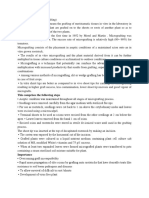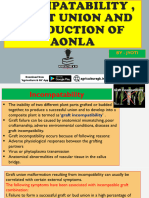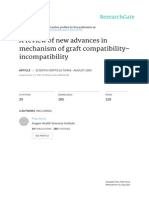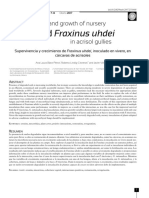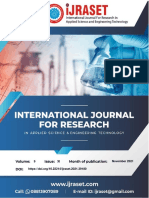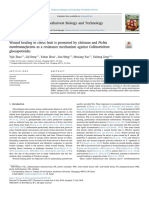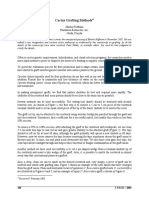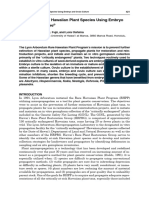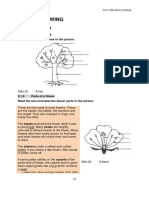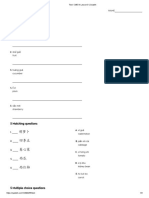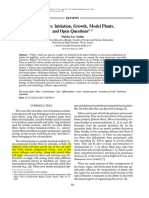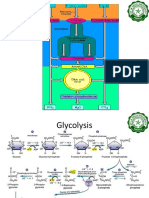Mikrografting Pir
Uploaded by
Nailulkamal DjamasMikrografting Pir
Uploaded by
Nailulkamal DjamasTarım Bilimleri Dergisi Journal of Agricultural Sciences
Tar. Bil. Der.
Dergi web sayfası: Journal homepage:
www.agri.ankara.edu.tr/dergi www.agri.ankara.edu.tr/journal
Morphological and Anatomical Investigations on in Vitro Micrografts
of OHxF 333 / Pyrus elaeagrifolia Interstock / Rootstock Combination
TARIM BİLİMLERİ DERGİSİ — JOURNAL OF AGRICULTURAL SCIENCES 20 (2014) 269-279
in Pears
Hatice DUMANOĞLUa, Aysun ÇELİKa, H. Nurhan BÜYÜKKARTALb, Saeed DOUSTİa
a
Ankara University, Faculty of Agriculture, Department of Horticulture, 06110, Ankara, TURKEY
b
Ankara University, Faculty of Sciences, Department of Biology, 06100, Ankara, TURKEY
ARTICAL INFO
Research Article
Corresponding Author: Hatice DUMANOĞLU, E-mail: dmanoglu@agri.ankara.edu.tr, Tel: +90 (312) 596 12 99
Received: 03 December 2013, Received in Revised Form: 02 January 2014, Accepted: 13 January 2014
ABSTRACT
In this study, possibility of creating a specific interstock / rootstock combination to obtain a clonal, semi dwarf, composite
pear rootstock tolerant to various stresses by micrografting was investigated. In vitro shoots of ‘Old Home x Farmingdale
333’ (Pyrus communis L.) which is a clonal semi dwarf pear rootstock resistant to fireblight and pear decline was used
as interstock, and in vitro Pyrus elaeagrifolia Pallas seedlings known as tolerant to Fe-chlorosis, salinity and drought
stresses was used as rootstock. Cleft grafting was applied in micrografts. Grafted seedlings were cultured on Murashige
and Skoog basal medium with ½ strength of macronutrients for 8 weeks under white fluorescent light for 16 h day-1.
Cultures, except the control, received complete darkness either 1 or 2 weeks at the beginning of incubation. Graft take
success in the control treatment was significantly higher (97.9%) than darkness treatments of 1 or 2 weeks (90.5% and
82.5%, respectively). Ultrastructural observations with transmission electron microscope revealed that dividing cambial
initials reached to 2-3 layers, and new xylem and phloem elements distinctly differentiated in transverse sections of the
graft union 8 weeks after micrografting in the control and darkness treatments. The results indicated a successful graft
union formation.
Keywords: Micrografting; Graft union; Interstock; Darkness treatment
Armutlarda OHxF 333 / Pyrus elaeagrifolia Ara Anaç / Anaç
Kombinasyonunun in vitro Mikroaşılarında Morfolojik ve Anatomik
İncelemeler
ESER BİLGİSİ
Araştırma Makalesi
Sorumlu Yazar: Hatice DUMANOĞLU, E-posta: dmanoglu@agri.ankara.edu.tr, Tel: +90 (312) 596 12 99
Geliş Tarihi: 03 Aralık 2013, Düzeltmelerin Gelişi: 02 Ocak 2014, Kabul: 13 Ocak 2014
Morphological and Anatomical Investigations on in Vitro Micrografts of OHxF 333 / Pyrus elaeagrifolia Interstock..., Dumanoğlu et al
ÖZET
Bu çalışmada, mikroaşılama yoluyla çeşitli streslere tolerant, klonal, yarı bodur, birleşik bir armut anacı elde etmek
için spesifik bir ara anaç / anaç kombinasyonu oluşturmanın olabilirliği araştırılmıştır. Ateş yanıklığı ve armut göçüren
hastalıklarına dayanıklı, yarı-bodur armut klon anacı ‘Old Home x Farmingdale 333’ (Pyrus communis L.)’ün in
vitro sürgünleri ara anaç ve demir klorozu, tuzluluk ve kuraklık streslerine tolerant olarak bilinen Pyrus elaeagrifolia
Pallas’ın in vitro çöğürleri anaç olarak kullanılmıştır. Mikroaşılarda yarma aşı tekniği uygulanmıştır. Aşılanmış
çöğürler, makro element düzeyi ½ olan Murashige ve Skoog temel besin ortamı üzerinde, 8 hafta süreyle, 16 h gün-1
süreyle beyaz floresan ışık altında inkübe edilmiştir. Kontrol dışındaki kültürler, inkübasyonun başlangıcında, 1 ya da
2 hafta süreyle tamamen karanlık koşullara alınmıştır. Aşı başarısı kontrol uygulamasında (% 97.9), 1 ya da 2 hafta
karanlık uygulamalarından (sırasıyla, % 90.5 ve % 82.5) önemli düzeyde daha yüksek olmuştur. Mikroaşılamadan 8
hafta sonra aşı kaynaşma yerinden alınan enine kesitlerde, transmisyon elektron mikroskopu ile yapılan ultrastrüktürel
gözlemler, kontrolde ve karanlık uygulamalarında kambiyal inisyallerin bölünerek 2-3 sıraya ulaştığını ve yeni ksilem
ve floem elemanlarının belirgin biçimde farklılaştığını ortaya koymuştur. Bulgular başarılı bir aşı kaynaşmasının
meydana geldiğini göstermiştir.
Anahtar Kelimeler: Mikroaşılama; Aşı kaynaşması; Ara anaç; Karanlık uygulaması
© Ankara Üniversitesi Ziraat Fakültesi
1. Introduction propagation methods, and also for studying more
Native Mediterranean Pyrus species P. elaeagrifolia in depth the relationships between genetically
Pallas which has habitat ranging from Turkey to different tissues and cells (Monteuuis 2012). In
Southeastern Europe and Ukraine (Bell 1990), is a initial studies, the objective of micrografting was
potential pear rootstock in areas where lime, salt and elimination of some virus diseases in tree fruit
drought are limiting factors for growing many Pyrus species (Jonard 1986). Murashige et al (1972) and
species (Lombard & Westwood 1987; Matsumoto et Navarro et al (1975) were first to consider the use
al 2006). Scions of cultivars (Pyrus communis L.) of micrografting technique in Citrus species in
grafted on P. elaeagrifolia grow vigorously similar order to eliminate virus diseases. Micrografting
to pear seedlings causing a long juvenile period. This has been successfully applied in Citrus (Edriss &
problem could be overcome by using a dwarf or semi Burger 1984; Sharma et al 2008), Prunus (Barba
dwarf clonal Pyrus interstocks such as ‘OHxF 333’ et al 1995; Jarausch et al 1999; Conejero et al
on P. elaeagrifolia. It is known that interstocks may 2013), Malus (Huang & Millican 1980; Bisognin
reduce vegetative growth and enhance reproductive et al 2008) and Pyrus (Faggioli et al 1997)
growth of the tree. Such double-worked plants species to get plants free from virus or virus like
have two unions, one between the rootstock and organisms. Besides, micrografting has been used for
interstock and one between the interstock and the micropropagation, rejuvenation of mature tissues,
scion. The interstock piece is budded or grafted or determination of graft incompatibility and root to
bench grafted onto the rootstock prior to combine shoot communication, transport or cryopreservation
with the scion cultivar (Hartmann et al 2011). in Citrus (Obeidy & Smith 1991; Parthasarathy et
However, production of grafted-rootstock plants al 1997; Volk et al 2012), Prunus and Amygdalus
using conventional techniques takes time for at least (Ozzambak & Schmidt 1991; Ghorbel et al 1999;
more than one year considering the growth time of Amiri 2006; Yıldırım et al 2010; Isikalan et al
rootstock lines (Elivar & Dumanoğlu 1999). 2011), Malus (Lane et al 2003; Nunes et al 2005;
In vitro grafting is an original and skillful Dobranszki & Silva 2010), Pyrus (Musacchi et al
technique which deserves greater consideration 2004; Espen et al 2005; Hassanen 2013), Pistacia
for overcoming the limitations of other vegetative (Abousalim & Mantell 1992; Onay et al 2003; 2004;
270 Ta r ı m B i l i m l e r i D e r g i s i – J o u r n a l o f A g r i c u l t u r a l S c i e n c e s 20 (2014) 269-279
Armutlarda OHxF 333 / Pyrus elaeagrifolia Ara Anaç / Anaç Kombinasyonunun in vitro Mikroaşılarında Morfolojik..., Dumanoğlu et al
Can et al 2006; Ozden-Tokatlı 2010), Castanea and radical of the seed was in the medium. Five seeds
Corylus (Nas & Read 2003), Actinidia (Ke et al were placed in each petri dish (70 x 10 mm). The
1993), Olea (Toroncoso et al 1999), Morus (Ma et seeds were stratified in vitro at 4 °C in dark for 8
al 1996), Anacardium (Thimmappaiah et al 2002), weeks in order to break dormancy. Chilled seeds
Opuntia (Estrada-Luna et al 2002) and Carica were germinated in a growth chamber at 25 ± 1
(Nava et al 2011) species. Creation of rootstocks by °C under 16/8 h day-1 (light/dark) photoperiod
interstock/rootstock combination is possible by in (cool white fluorescent light, 35 µmol m-2 s-1)
vitro micrografting which is very fast, using in vitro for 10-14 days. MS basal medium (Murashige &
rooted young rootstock plantlets and in vitro grown Skoog 1962) with half-strength of macronutrients,
interstock scions. Thus, micrografting technique containing 3% (w v-1) sucrose and 1% (w v-1) Difco
offers new possibilities for mass production of Bacto agar was used in seed stratification and
grafted rootstocks which might be later grafted in germination studies. The pH was adjusted to 5.8
vitro or in vivo with the scion cultivar. Up to date, before adding agar and autoclaving at 121 °C for
we are unaware of micrografting studies which 20 min.
have been done for micropropagation of rootstocks
grafted with interstock. In vitro shoots obtained from shoot-tip culture
of ‘OHxF 333’ were used as scion (interstock).
The objective of this study was to develop a Shoot-tip cultures were established from actively
quick in vitro micrografting technique to create growing shoots of plants. Shoot tips approximately
a specific pear rootstock combination using semi
20 mm long were collected, washed in running
dwarf clonal interstock (‘Old Home x Farmingdale
tap water for 30 min, and sterilized by immersion
333’, (OHxF 333)) and the vigorous seedling
in a solution of sodium hypochlorite (1% active
rootstock tolerant to different stress conditions (P.
chlorine) for 20 min followed by 3 rinses with
elaeagrifolia), and to study graft union formation on
sterile distilled water for 5 min. Approximately
in vitro micrografted and complate darkness treated
10 mm long explants were cultured in glass tubes
plantlets, since complete darkness may prevent
(120 x 25 mm) containing 10 mL of medium under
internal auxin degradation, by morphological and
aseptic conditions. The shoots (>10 mm long) from
anatomical (Transmission Electron Microscope)
investigations. initial cultures were subcultured four times by four
week intervals in glass flasks (250 mL) containing
50 mL of medium.
2. Material and Methods
For initial culture and subcultures, MS basal
2.1. Rootstock and scion (interstock) sources for medium containing 3% (w v-1) sucrose and 0.7% (w
micrografting experiments v-1) agar was used. MS medium was supplemented
In vitro germinated seedlings of P. elaeagrifolia with 4.4 µM BA and 0.9 µM GA3 which were were
Pallas were used as the rootstock. The seeds were added to media before autoclaving at 121 °C for 20
processed before culturing in aseptic conditions min. The pH was adjusted to 5.8 before adding agar.
as follows; (1) the seeds were scarified in sulfuric All cultures were incubated at the same conditions
acid (Merck, 95–98% H2SO4) for 2.5 min followed as seed germination.
by rinsing in running water for 5 min, (2) the seeds
2.2. In vitro micrografting experiments
were dipped in 85% ethanol for 3 min, and then
sterilized in a solution of sodium hypochlorite Cleft grafting was applied in micrografts under
(2.5% active chlorine) for 30 min followed by 3 aseptic conditions. About 10-14 day-old seedlings
rinses for 5 min with sterile distilled water. Then, with horizontal cotyledonary leaves, without true
the seeds were placed on germination medium in leaves, with roots about 15-30 mm in length were
petri dishes by positioning vertically so that the used as rootsock in grafts (Figure 1A).
Ta r ı m B i l i m l e r i D e r g i s i – J o u r n a l o f A g r i c u l t u r a l S c i e n c e s 20 (2014) 269-279 271
Morphological and Anatomical Investigations on in Vitro Micrografts of OHxF 333 / Pyrus elaeagrifolia Interstock..., Dumanoğlu et al
Figure 1- Micrografting procedure of interstock ‘OHxF 333’ on Pyrus elaeagrifolia seedling under aseptic
conditions. An in vitro germinated P. elaeagrifolia seedling (A); forming a cleft at about 2-3 mm in length
on the top of hypocotyle of seedling which was cut just below the cotyledon leaves (B); an in vitro grown
seedling ready for micrografting (C); a scion prepared from an in vitro grown interstock ‘OHxF 333’ micro
shoots ready to be inserted into the cleft (D); an inserted scion into the cleft (E); a graft union wrapped
around with sterile aluminum foil (F); a micrografted plantlet taken out from in vitro conditions after 8
weeks of grafting (G)
Şekil 1- Pyrus elaeagrifolia çöğürleri üzerine ‘OHxF 333’ ara anacının, aseptik koşullarda mikroaşılama
işlemi. İn vitro koşullarda çimlendirilmiş P. elaeagrifolia çöğürleri (A); kotiledon yaprakların hemen altından
tepesi vurulmuş fidelerin hipokotilinin üst kısmında yaklaşık 2-3 mm uzunluğunda bir yarık oluşturulması (B);
mikroaşılama için hazır bir in vitro çöğür (C); in vitro koşullarda geliştirilmiş ara anaç ‘OHxF 333’den kalem
olarak hazırlanmış, yarık içerisine yerleştirilmeye hazır mikro sürgünler (D); yarık içerisine kalemin yerleştirilmesi
(E); aşı yerinin steril alüminyum folyo ile sarılması (F); aşılamadan 8 hafta sonra in vitro koşullardan çıkartılmış
bir mikroaşılı bitkicik (G)
The roots were cut to ~20 mm length. The tip of medium in glass tubes (120 x 25 mm) containing
hypocotyl was decapitated just below the cotyledons. 10 mL of half-strength MS basal medium without
The stem was cut longitudinally 2-3 mm deep growth regulators containing 3% (w v-1) sucrose and
(Figure 1B & C). The scion, prepared from in vitro 0.7% (w v-1) agar. The pH was adjusted to 5.8 before
shoots of ‘OHxF 333’ was about 10 mm long and adding agar and autoclaving.
contained the apical meristem with 2-3 leaves. The For the micrografting experiments, grafted
basal end of the scion was cut to form a wedge about seedlings received either complete darkness for 1 or
2-3 mm long (Figure 1D). The scion was inserted 2 weeks in a growth chamber or 16/8 h day-1 (light
into the cleft and the graft junction was wrapped / night) photoperiod (control) at 25 ± 1 °C. At the
with a sterile 5 x 20 mm piece of aluminum foil (12 end of the dark treatments, cultures were incubated
µ thick) which was folded 4 times (Figure 1E & F). under the photoperiod as the control received.
The basal end of grafted seedlings was placed in the The micrografting experiments were a completely
medium with the graft junction above the level of randomized design with four replications with
272 Ta r ı m B i l i m l e r i D e r g i s i – J o u r n a l o f A g r i c u l t u r a l S c i e n c e s 20 (2014) 269-279
Armutlarda OHxF 333 / Pyrus elaeagrifolia Ara Anaç / Anaç Kombinasyonunun in vitro Mikroaşılarında Morfolojik..., Dumanoğlu et al
25 micrografts (tubes) in each replication. The transferred to 100% propylene oxide and embedded
experiment was repeated at least twice to ensure the in Epon 812 (Luft 1961). Ten blocks were prepared
accuracy of results. for each treatment. Ultrathin sections were stained
with uranyl acetate (Stempak & Ward 1964) and
2.3. Morphological investigations of micrografted lead citrate (Sato 1967). Ultrastructural observations
plantlets were made under Jeol CXII Transmission Electron
Grafted plantlets were removed from in vitro Microscope at 80 Kv.
conditions 8 weeks after micrografting and the
aluminum band was removed (Figure 1G). Percent 3. Results and Discussion
graft take, graft junction rating on a scale of 1 to 3 (1
= weak, 2 = medium, 3 = good) by visual inspection, In this study, very high graft take success was obtained
shoot length and number of leaves on the shoots in the micrografts of ‘OHxF 333’ / P. elaeagrifolia
were recorded. Morphological data were subjected seedlings. Based on morphological observations, the
to analyses of variance (ANOVA) at P<0.05, 0.01 highest graft take and graft junction rating was 97.9%
or 0.001 using MINITAB statistical software and 2.70%, respectively (Table 1).
(MINITAB Inc., UK). Means were separated Hassanen (2013) found that the highest percentage
by Duncan’s multiple range test at P = 0.05. The of successful grafts was 83% in the Le-Cont pear /
percent data were transformed into angle values Pyrus betulaefolia combination. Nunes et al (2005)
prior to analyses. reported that in vitro micrografting techniques offer
the potential for effective propagation of high quality
2.4. Preparation of epon blocks and anatomic genetic material in a short time under controlled and
investigations aseptic conditions. Grafting techniques and initial
Tissue samples in size of 2 mm lenght were taken treatments applied prior to in vitro micrograftings
from the graft union 8 weeks after the micrografts are subjects of concern. Cleft grafting was used
were made. The samples were fixed in 3% in this study because it has been reported as a
glutaraldehyde buffered with 0.1 M phosphate (pH successful micrografting technique in different fruit
7.2) for 3 h and then fixed in 1% osmium tetraoxide species such as cherry, pistachio, olive (Ozzambak
(in 0.1 M Na-P buffer) for 3 h at room temperature. & Schmidt 1991; Abousalim & Mantell 1992;
Specimens were dehydrated in an ethanol series, Toroncoso et al 1999; Onay et al 2004).
Table 1- The effect of complete darkness treatments applied at the beginning of incubation, on graft
take success and shoot development in ‘OHxF 333’ / Pyrus elaeagrifolia seedling interstock/ rootstock
combinations in vitro (after 8 weeks of micro-cleft graftings)
Çizelge 1- İn vitro koşullarda inkübasyon başlangıcında uygulanan tamamen karanlık uygulamalarının ‘OHxF
333’ / Pyrus elaeagrifolia çöğürü ara anaç / anaç kombinasyonunda aşı başarısı ve sürgün gelişimi üzerine
etkileri (mikro-yarma aşılamadan 8 hafta sonra)
Graft take Graft junction rating Shoot length Number of
Treatments
(%) (1-3) (mm) leaves
Control 97.9a 2.70 ± 0.06a 13.9 ± 0.8a 6.8 ± 0.5a
Complete darkness for a week 90.5b 2.33 ± 0.13b 10.6 ± 0.4b 3.9 ± 0.0b
Complete darkness for two weeks 82.5b 2.09 ± 0.13b 10.9 ± 0.6b 4.5 ± 0.3b
P 0.001 0.011 0.011 0.000
Graft junction rating 1, weak; 2, medium; 3, good. Means in each column followed by the same letter were not significantly different
at P = 0.05, according to Duncan’s new multiple range test
Ta r ı m B i l i m l e r i D e r g i s i – J o u r n a l o f A g r i c u l t u r a l S c i e n c e s 20 (2014) 269-279 273
Morphological and Anatomical Investigations on in Vitro Micrografts of OHxF 333 / Pyrus elaeagrifolia Interstock..., Dumanoğlu et al
We applied complete dark treatment for 1 or 2 Transverse sections of a region near graft
weeks as an initial procedure with an expectation elements showed that parenchymatous cells forming
of increasing graft take success by promoting callus callus tissue were large and had larger intercellular
formation due to its role in internal auxin biosynthesis spaces. In some of these cells the cytoplasm was less
(Yin et al 2012). Endogenous growth regulators dense and contained vacuoles and a few organelles
have been proposed to play a key role in grafting, (Figure 2B). Some enlarged cells and occasionally
with special reference to auxin which is known to divided cambial initials were observed at the graft
be synthesized in shoot apices and degraded by union. Cambial cells were formed by couple of cell
light. Our results showed that although graft take layers (Figure 2C), and cytoplasm of some of the
success, graft junction rating, leaf number and shoot cells were dense (Figure 2D). Xylem elements and
development were satisfactory in all treatments, the phloem cells were formed by couple of cell layers
control treatment performed significantly better than and they were starting to differentiate. Tracheal
the dark treatments (Table 1). The control treatment elements which were in the process of differentiation
had the highest graft take among the treatments had reached their normal size and the lumen of the
(P = 0.001) which was followed by 1 week (90.5%) cell was dense with electrons (Figure 2E). Phloem
and 2 weeks (82.5%) darkness treatments although cells were found to be round, isodiametric or
the difference between last two was not statistically hexagonal in shape, thin walled and dispersed.
significant. The grade for level of graft junction
In one week complete darkness treatment,
was also high on grafts and the differences were
parenchymatous cells with rough walls forming the
significant. The control treatment had the highest
callus tissue between the graft elements were plenty
grade (2.70 ± 0.06) followed by 1 week (2.33 ±
and the cytoplasm stained dark (Figure 3A). At this
0.13) and 2 weeks of complete darkness (2.09
stage, the cambial relation was present between
± 0.13) treatments. (Table 1). The results are in
graft elements. Cambium cells were formed with
agreement with the report of Monteuuis (1996)
cells of different sizes and occasionally formed 7 or
that the application of dark treatment for 2 weeks
8 layers. These cells had thin walls, were rectangular
in in vitro micrografts did not improve the results
in shape, and formed radial rows. The cytoplasm
in Acacia mangium. On the other hand, Monteuuis
stained very dark in some cells. There were few
(1994) observed beneficial effects of 2 weeks to
newly formed xylem and phloem elements (Figure
3 weeks in darkness immediately after grafting in
3B).
vitro seedlings of Picea abies which resulted in
52.4% success as compared to 32.6% for the control. In two weeks of complete darkness treatment,
Similarly, 5 days of dark treatment shortened the callus tissue between the graft elements at the graft
time required for grafting and increased the graft union was dense in samples treated. The cells at the
union rate (90.6%) compared with the control union tissues were generally flattened and dispersed.
(80.7%) in the plug seedling of rose rootstock (Han However, parenchymatous cells producing the
et al 1998). callus tissue were formed by large cells with large
inter-cellular spaces. The cytoplasm in some cells
Ultrastructural observations with transmission
electron microscope in ‘OHxF 333’ / P. elaeagrifolia was dense. Cambium was formed of couple of cell
micrografts revealed the successful graft union rows and the cytoplasm in some cells was dense.
formation, and new xylem and phloem elements At this stage, the established cambial relation
differentiated in all of the treatments. In the control, between graft elements was very clear. New xylem
observation of callus tissue between graft elements and phloem elements were few in number and they
at the graft union revealed that the cells at the graft started to differentiate (Figure 4).
union were generally oval in shape and scattered Espen et al (2005) indicated that the incompatible
(Figure 2A). heterograft (Pyrus communis L. cv. ‘Bosc’ (B) /
274 Ta r ı m B i l i m l e r i D e r g i s i – J o u r n a l o f A g r i c u l t u r a l S c i e n c e s 20 (2014) 269-279
Armutlarda OHxF 333 / Pyrus elaeagrifolia Ara Anaç / Anaç Kombinasyonunun in vitro Mikroaşılarında Morfolojik..., Dumanoğlu et al
Figure 2- Transversal sections of the graft union in the control treatment after 8 weeks of micrografts.
Rs, rootstock (P. elaeagrifolia seedling); Sc, scion (OHxF 333 interstock); Xy, xylem; C, cambium; Pa,
parenchymatous cell. Semithin section showing parenchymatous cells at the graft union Bar= 20 µm (A);
electron micrograph showing detail of parenchymatous cell cytoplasm Bar= 3 µm (B); semithin section
showing cambial cells and newly differentiated xylem and phloem cells Bar= 50 µm (C); the cytoplasm of
the active cambial cells Bar= 3 µm (D); detail of the newly differentiated xylem cells Bar= 3 µm (E)
Şekil 2- Mikroaşılamadan 8 hafta sonra kontrol uygulamasında aşı kaynaşma yerinden alınan enine kesitler.
Rs, anaç (P. elaeagrifolia çöğürü); Sc, ara anaç (OHxF 333); Xy, ksilem; C, kambiyum; Pa, parankimatik
hücre. Aşı kaynaşma yerinde parankimatik hücreleri gösteren yarı ince kesit Bar= 20 µm (A); parankimatik
hücre sitoplazmasının ince yapısını gösteren elektron mikrografisi Bar= 3 µm (B); kambiyum hücreleri ve yeni
farklılaşmış ksilem ve floem hücrelerini gösteren yarıince kesit Bar= 50 µm (C); aktif kambiyum hücrelerinin
sitoplazması Bar= 3 µm (D); yeni farklılaşmış ksilem hücrelerinin ince yapısı Bar= 3 µm (E)
Cydonia oblonga Mill. East Malling clone C BH) and the compatible heterograft (BH / EMC).
(EMC)) showed a marked delay in internode Thus we believe that, ‘OHxF 333’ / P. elaeagrifolia
cohesion compared with the autografts of B / B, combination would form a compatible heterograft.
and Pyrus communis L. cv. ‘Butirra Hardy’ (BH /
Ta r ı m B i l i m l e r i D e r g i s i – J o u r n a l o f A g r i c u l t u r a l S c i e n c e s 20 (2014) 269-279 275
Morphological and Anatomical Investigations on in Vitro Micrografts of OHxF 333 / Pyrus elaeagrifolia Interstock..., Dumanoğlu et al
Figure 3- Transversal semithin sections of the graft union in 1 week complete darkness treatment after 8
weeks of micrografts. Rs, rootstock (P. elaeagrifolia seedling); Sc, scion (OHxF 333 interstock); Xy, xylem;
Ph, phloem; C, cambium; Pa, parenchymatous cell. Parenchymatous cells at the graft union Bar= 20 µm
(A), cambial cells, newly differentiated xylem and phloem cells Bar= 20 µm (B)
Şekil 3- Mikroaşılamadan 8 hafta sonra 1 hafta tamamen karanlık uygulamasında aşı kaynaşma yerinden alınan
enine kesitler. Rs, anaç (P. elaeagrifolia çöğürü); Sc, ara anaç (OHxF 333); Xy, ksilem; Ph, floem; C, kambiyum;
Pa, parankimatik hücre. Aşı kaynaşma yerinde parankimatik hücreler Bar= 20 µm (A), kambiyum hücreleri, yeni
farklılaşmış ksilem ve floem hücreleri Bar= 20µm (B)
Figure 4- Transversal sections of the graft union in 2 weeks complete darkness treatment after 8 weeks of
micrografts. Cambial ring and newly differentiated xylem and phloem cells Bar= 20 µm Rs, rootstock (P.
elaeagrifolia seedling); Sc, scion (OHxF 333 interstock); Xy, xylem; Ph, phloem; C, cambium
Şekil 4- Mikroaşılamadan 8 hafta sonra 2 hafta tamamen karanlık uygulamasında aşı kaynaşma yerinden
alınan enine kesitler. Kambiyum halkası ve yeni farklılaşmış ksilem ve floem hücreleri Bar= 20µm Rs, anaç (P.
elaeagrifolia çöğürü); Sc, ara anaç (OHxF 333); Xy, ksilem; Ph, floem; C, kambiyum
276 Ta r ı m B i l i m l e r i D e r g i s i – J o u r n a l o f A g r i c u l t u r a l S c i e n c e s 20 (2014) 269-279
Armutlarda OHxF 333 / Pyrus elaeagrifolia Ara Anaç / Anaç Kombinasyonunun in vitro Mikroaşılarında Morfolojik..., Dumanoğlu et al
4. Conclusions vera L. var. Siirt, on wild pistachio rootstocks. Journal
of Molecular Cell Biology 5: 25-31
In vitro micrografting technique was successfully
Conejero A, Romero C, Cunill M, Mestre M A, Martínez-
applied to create ‘OHxF 333’ / P. elaeagrifolia
Calvo J, Badenes M L & Llácer G (2013). In vitro
seedling combination. Thus, with mass shoot-tip grafting for safe Prunus budwood exchange.
micropropagation it is possible to shorten the Scientia Horticulturae 150: 365-370
required time for production of a pear rootstock
Dobranszki J & Silva J A T (2010). Micropropagation of
consisted of rootstock and interstock which is apple - A review. Biotechnology Advances 28: 462-
clonal, semi dwarf, tolerant to Fe-chlorosis, salinity 488
and drought stresses, and resistant to fireblight and
Edriss M H & Burger D W (1984). Micro-grafting shoot-
pear decline less than a year. This is the first report of tip culture of Citrus on three trifoliolate rootstocks.
in vitro micrografting on Pyrus elaeagrifolia Pallas Scientia Horticulturae 23: 255-259
wild pear, and micropropagation of rootstock plants Elivar D E & Dumanoğlu H (1999). Ayaş (Ankara)
which are micrografted with interstock in vitro. koşullarında elma, armut ve ayvada bir yaşlı fidan
Abbreviations and Symbols üretiminde ilkbahar sürgün ve sonbahar durgun göz
aşılarının karşılaştırılması. Tarım Bilimleri Dergisi
C cambium 5(2): 58-64
MS murashige & skoog Espen L, Cocucci M & Sacchi G A (2005). Differentiation
Pa parenchymatous and functional connection of vascular elements in
Ph phloem compatible and incompatible pear / quince internode
micrografts. Tree Physiology 25: 1419-1425
Rs rootstock (P. elaeagrifolia seedling)
Estrada-Luna A A, Lopez-Peralta C & Cardenas-Soriano
Sc scion (OHxF 333 interstock) E (2002). In vitro micrografting and the histology of
Xy xylem graft union formation of selected species of pricly
pear cactus (Opuntia spp.). Scientia Horticulturae 92:
317-327
References
Faggioli F, Martino L & Barba M (1997). In vitro
Abousalim A & Mantell S H (1992). Micrografting of
micrografting of Pyrus communis shoot tips. Advances
pistachio (Pistacia vera L. cv. Mateur). Plant Cell,
in Horticultural Science 11: 25-29
Tissue and Organ Culture 29: 231-234
Ghorbel A, Chatibi A, Thaminy, S & Kchouk M L (1999).
Amiri M A (2006). In vitro techniques to study the
Micrografting of almond Prunus dulcis (Miller) D.A.
shoot-tip grafting of Prunus avium L. (cherry) var.
Webb.) cv. Achak. Acta Horticulturae 470: 429-433
Seeyahe Mashad. Journal of Food Agriculture and
Environment 4: 151-154 Han Y Y, Woo J H, Sim Y G, Choi K B, Choi B S &
Yeo S K (1998). Studies on the plug seedling of
Barba M, Cupidi A, Loreti S, Faggioli F & Martino
rose rootstock (Rosa multiflora ‘Hort No. 1’). RDA
L (1995). In vitro micrografting: a technique to
eliminate peach latent mosaic viroid from peach. Acta Journal of Horticulture Science 40: 82-88
Horticulturae 386: 531-535 Hartmann H T, Kester D E, Davies F T & Geneve R L
Bell R L (1990). Pears (Pyrus). In: Moore J N & Ballington (2011). Plant Propagation: Principle and Practices.
J R (Eds), Genetic Resources of Temperate Fruit and Prentice-Hall, London
Nut Crops, International Society for Horticultural Hassanen S A (2013). In vitro grafting of pear (Pyrus
Science, Wageningen, pp. 655-696 spp.). World Applied Sciences Journal 21: 705-709
Bisognin C, Ciccotti A, Salvadori A, Moser M, Grando Huang S C & Millican D F (1980). In vitro micrografting
M S & Jarausch W (2008). In vitro screening for of apple shoot tips. HortScience 15: 741-743
resistance to apple proliferation in Malus species. Isıkalan C, Namli S, Akbas F & Ak B E (2011).
Plant Pathology 57: 1163-1171 Micrografting of almond (Amygdalus communis)
Can C, Ozaslan M, Toremen H, Sarpkaya K & Iskender cultivar ‘Nonpareil’. Australian Journal of Crop
E (2006). In vitro micrografting of pistachio, Pistacia Science 5: 61-65
Ta r ı m B i l i m l e r i D e r g i s i – J o u r n a l o f A g r i c u l t u r a l S c i e n c e s 20 (2014) 269-279 277
Morphological and Anatomical Investigations on in Vitro Micrografts of OHxF 333 / Pyrus elaeagrifolia Interstock..., Dumanoğlu et al
Jarausch W, Lansac M, Bliot C & Dosbat F (1999). Musacchi S, Ganino T, Grassi S & Fabbri A (2004).
Phytoplasma transmission by in vitro graft inoculation Grafting in vitro shoots on acclimating plants:
as a basis for a preliminary screening method for morphological and anatomical aspects of compatible
resistance in fruit trees. Plant Pathology 48: 283-287 and incompatible pear / quince combinations. Acta
Jonard R (1986). Micrografting and its applications to tree Horticulturae 658: 559-563
improvement. In: Bajaj Y P S (Ed). Biotechnology in Nas M N & Read P E (2003). Simultaneous micrografting,
Agriculture and Forestry, Springer, Berlin, pp. 31-48 rooting and acclimatization of micropropagated
Ke S, Cai Q & Skirvin R M (1993). Micrografting American chestnut, grapevine and hybrid hazelnut.
speeds growth and fruiting of protoplast-derived European Journal of Horticultural Science 68: 234-
clones of kiwifruit (Actinidia deliciosa). Journal of 237
Horticultural Science 68: 837-840 Nava R, Garcia A V, Marin C & Villegas Z (2011). Clonal
Lane W D, Bhagwat B, Armstrong J D & Wahlgren S propagation of elite Carica papaya L. plants using in
(2003). Apple micrografting protocol to establish vitro and in vivo micrografting. Interciencia 36: 517-
transgenic clones on field ready rootstock. 523
HortTechnology 13: 641-646 Navarro L, Roistacher C N & Murashige T (1975).
Lombard P B & Westwood M N (1987). Pear rootstocks. Improvment of shoot tip grafting in vitro for virus
In: Rom R C & Carlson R F (Eds). Rootstocks for free Citrus. Journal of the American Society for
Fruit Crops, A Wiley-Interscience Publication, John Horticultural Science 100: 471-479
Wiley and Sons, Inc., New York, pp. 145-183 Nunes J C O, Abreu M F, Dantas A C M, Pereira A J &
Luft J H (1961). Improvements in epoxyresin embedding Pedrotti E L (2005). Morphological characterization in
methods. The Journal of Biophysical and Biochemical apple micrografts. Revista Brasileira de Fruticultura
Cytology 9: 409-414 27: 80-83
Ma F, Guo C, Liu Y, Li M, Ma T, Mei L & Hsiao A (1996). Obeidy A A & Smith M A L (1991). A versatile new tactic
In vitro shoot-apex grafting of mulberry (Morus alba for fruit tree micrografting. HortTechnology 1: 91-95
L.). HortScience 31: 460-462 Onay A, Pirinc V, Adıyaman F, Isıkalan C, Tilkat E &
Matsumoto K, Tamura F, Chun J P & Tanabe K Basaran D (2003). In vivo and in vitro micrografting
(2006). Native Mediterranean Pyrus rootstock, of pistachio, Pistacia vera L. cv. “Siirt”. Turkish
P. amygdaliformis and P. elaeagrifolia, present Journal of Biology 27: 95-100
higher tolerance to salinity stress compared with Onay A, Pirinc V, Yıldırım H & Basaran D (2004). In vitro
Asian Natives. Journal of the Japanese Society for micrografting of mature pistachio (Pistacia vera var.
Horticultural Science 75: 450-457 Siirt). Plant Cell, Tissue and Organ Culture 77: 215-
Monteuuis O (1994). Effect of technique and darkness on 219
the success of meristem micrografting of Picea abies. Ozden-Tokatlı Y, Akdemir H, Tilkat E & Onay A
Silvae Genetica 43: 91-95 (2010). Current status and conservation of Pistacia
Monteuuis O (1996). In vitro shoot apex micrografting germplasm. Biotechnology Advances 28: 130-141
of mature Acacia mangium. Agroforestry Systems 34: Ozzambak E & Schmidt H (1991). In vitro and in
231-217 vivo micrografting of cherry (Prunus avium L.).
Monteuuis O (2012). In vitro grafting of woody species. Gartenbauwissenschaft 56: 221-223
Propagation of Ornamental Plants 12: 11-24 Parthasarathy V A, Nagaraju V & Rahman S A S (1997).
Murashige T & Skoog F (1962). A revised medium for In vitro grafting of Citrus reticulata Blanco. Folia
rapid growth and bioassays with tobacco tissue Horticulturae 9: 87-90
cultures. Physiologia Plantarum 15: 473-497 Sato J E (1967). A modifred method for load staining of
Murashige T, Bitters W P, Rangan T S, Nauer E M, thin sections. Journal of Electron Microscopy 16: 133
Roistacher C N & Holliday B P (1972). A technique Sharma S, Singh B, Rani G, Zaidi A A, Halan V K,
of shoot apex grafting and its utilization towards Nagpal A K & Virk G S (2008). In vitro production
recovering virus free Citrus clones. HortScience 7: of Indian citrus ringspot virus (ICRSV) free Kinnow
118-119 plants employing thermotherapy coupled with shoot
278 Ta r ı m B i l i m l e r i D e r g i s i – J o u r n a l o f A g r i c u l t u r a l S c i e n c e s 20 (2014) 269-279
Armutlarda OHxF 333 / Pyrus elaeagrifolia Ara Anaç / Anaç Kombinasyonunun in vitro Mikroaşılarında Morfolojik..., Dumanoğlu et al
tip grafting. Plant Cell, Tissue and Organ Culture 92: Volk G M, Bonnart R, Krueger R & Lee R (2012).
85-92 Cryopreservation of citrus shoot tips using
Stempak J C & Ward W P (1964). An improved staining micrografting for recovery. CryoLetters 33: 418-426
method for electron microscopy. The Journal of Cell Yıldırım H, Onay A & Suzerer V (2010). Micrografting
Biology 22: 697-701 of almond (Prunus dulcis Mill.) cultivars “Ferragnes”
Thimmappaiah G T, Puthra S & Anil S R (2002). In vitro and “Ferraduel”. Scientia Horticulturae 125: 361-
grafting of cashew (Anacardium occidentale L.). 367
Scientia Horticulturae 92: 177-182 Yin H, Yan B, Sun J, Jia P, Zhang Z, Yan X, Chai J,
Toroncoso A, Linan J, Cantos M, Acebedo M M & Ren Z, Zheng G & Liu H 2012. Graft-union
Rapoport H F (1999). Feasibility and anatomical development: a delicate process that involves cell–
development of an in vitro olive cleft-graft. The cell communication between scion and stock for
Journal of Horticultural Science & Biotechnology 74: local auxin accumulation. Journal of Experimental
584-587 Botany 63: 4219-4232
Ta r ı m B i l i m l e r i D e r g i s i – J o u r n a l o f A g r i c u l t u r a l S c i e n c e s 20 (2014) 269-279 279
You might also like
- Creating A Multi-Berry Shrub Via Cross GraftingNo ratings yetCreating A Multi-Berry Shrub Via Cross Grafting8 pages
- Lecture 11 HOR 111 Stock Scion RelationshipNo ratings yetLecture 11 HOR 111 Stock Scion Relationship27 pages
- Grafting For The Recovery of Yellow Passion FruitNo ratings yetGrafting For The Recovery of Yellow Passion Fruit8 pages
- Şeftali Ve Nektarin Anaçlarının, Kök Ur Nematodu Türleri Nin Farklı Popülasyonlarına Karşı ReaksiyonlarıNo ratings yetŞeftali Ve Nektarin Anaçlarının, Kök Ur Nematodu Türleri Nin Farklı Popülasyonlarına Karşı Reaksiyonları8 pages
- Effect of Different Rootstocks On The Yield and Quality of Grafted Melon PlantsNo ratings yetEffect of Different Rootstocks On The Yield and Quality of Grafted Melon Plants6 pages
- Application of Tissue Culture in Plant RNo ratings yetApplication of Tissue Culture in Plant R3 pages
- Graft Compatibility-Incompatibility in Fruit Crops: Mechanism and Determination TechniquesNo ratings yetGraft Compatibility-Incompatibility in Fruit Crops: Mechanism and Determination Techniques9 pages
- Graft Union Formation of Spur Apple Varieties Grafted On Different RootstocksNo ratings yetGraft Union Formation of Spur Apple Varieties Grafted On Different Rootstocks4 pages
- Identification of Some Cucurbitaceous Rootstocks For Vegetable Crops in RomaniaNo ratings yetIdentification of Some Cucurbitaceous Rootstocks For Vegetable Crops in Romania7 pages
- A Review of New Advances in Mechanism of Graft Compatibility - IncompatibilityNo ratings yetA Review of New Advances in Mechanism of Graft Compatibility - Incompatibility12 pages
- Supervivencia y Crecimiento de Fraxinus Uhdei, Inoculado en Vivero, en Cárcavas de AcrisolesNo ratings yetSupervivencia y Crecimiento de Fraxinus Uhdei, Inoculado en Vivero, en Cárcavas de Acrisoles8 pages
- Mitigating Abiotic and Biotic Stress in Vegetable Crops Through Grafting Strategies.No ratings yetMitigating Abiotic and Biotic Stress in Vegetable Crops Through Grafting Strategies.6 pages
- Rejuvenation of Reserve Forest by Forest Interventions (Species and Different Plantations)No ratings yetRejuvenation of Reserve Forest by Forest Interventions (Species and Different Plantations)7 pages
- Micropropagation of Anthurium Andraeanum From LeafNo ratings yetMicropropagation of Anthurium Andraeanum From Leaf8 pages
- 8determining Mycorrhiza Rate in Some Oak Species Inoculated With Tuber Aestivum Vittad. (Summer Truffle)No ratings yet8determining Mycorrhiza Rate in Some Oak Species Inoculated With Tuber Aestivum Vittad. (Summer Truffle)7 pages
- Grafting and Budding Nursery Crop PlantsNo ratings yetGrafting and Budding Nursery Crop Plants37 pages
- Okra Seed Production and Quality in Relation To Pod Maturity at HarvestNo ratings yetOkra Seed Production and Quality in Relation To Pod Maturity at Harvest8 pages
- Anatomy and Physiology of Graft Incompatibility in Solanaceous PlantsNo ratings yetAnatomy and Physiology of Graft Incompatibility in Solanaceous Plants9 pages
- Postharvest Biology and Technology: A B A B A A B A B A BNo ratings yetPostharvest Biology and Technology: A B A B A A B A B A B10 pages
- Ojsadmin, 11 Vegetable Grafting For Combating Stresses andNo ratings yetOjsadmin, 11 Vegetable Grafting For Combating Stresses and5 pages
- The Recovery of Hawaiian Plant Species Using Embryo and Ovulo CultureNo ratings yetThe Recovery of Hawaiian Plant Species Using Embryo and Ovulo Culture3 pages
- Structure and Development of Root, Stem and LeafNo ratings yetStructure and Development of Root, Stem and Leaf83 pages
- Fruit Growing 3.1. Fruit Trees: 3.1.1. Parts of A Tree Label The Parts of The Tree in The PictureNo ratings yetFruit Growing 3.1. Fruit Trees: 3.1.1. Parts of A Tree Label The Parts of The Tree in The Picture8 pages
- Reproduction Methods in Class 10 ScienceNo ratings yetReproduction Methods in Class 10 Science42 pages
- Jurnal Internasional (Pembentukan Jaringan Tumbuhan)No ratings yetJurnal Internasional (Pembentukan Jaringan Tumbuhan)11 pages
- Practical Mannual-Production Technology For Fruit and PlanttioncropNo ratings yetPractical Mannual-Production Technology For Fruit and Planttioncrop76 pages
- Cannabis Grow Course 101 - Module 2 - Prepare (Lesson 3)No ratings yetCannabis Grow Course 101 - Module 2 - Prepare (Lesson 3)5 pages
- Crandall ST Etal PhylogClassifMarch2009No ratings yetCrandall ST Etal PhylogClassifMarch200944 pages
- Actlnldlaceae: Scientific Name: Saurauia Bontocensis Merr. Common Name: DagweyNo ratings yetActlnldlaceae: Scientific Name: Saurauia Bontocensis Merr. Common Name: Dagwey41 pages
- G6 Natural Bracing in Trees - ManagementNo ratings yetG6 Natural Bracing in Trees - Management29 pages



